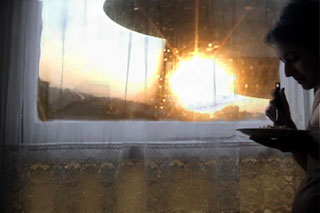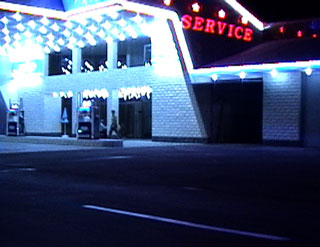
|
The difficult position of the first generation born in the new country after migration is to embody the crossroads where different cultures meet to negotiate their claims – not on geopolitical territories but on the minute events, actions, and reactions of our everyday lives. We are compromised bodies; hearing one language with one ear and another with the other, we are equipped to understand only half of what’s said everywhere we go. Permanent Transit takes viewers on a journey through 11 countries between East and West (Lebanon, Syria, Jordan, Palestine, Turkey, Armenia, Italy, the Netherlands, Russia, the UK and the USA), glimpsed only through the frames of various windows. These constantly shifting landscapes are woven together with multiple layers of everyday sounds and the scraps of a dozen stories from the lives of expatriates, exiles, refugees, itinerants, children of divorce and children of immigrants.
All of these documentary elements ultimately feed into and complement the absurd, appropriated, overarching narrative of a traveler who becomes trapped in the nomansland between two borders and must find a way to make his home there -- retold through many gaps of memory by my mother from a television bit made famous by comedian Doreid Laham during the Lebanese civil war. Permanent Transit is an experimental documentary, a video database, a fractured narrative, a reconstituted journey, a memory experiment, and an extended conversation between friends and strangers: all designed to dislocate viewers from their ordinary lives and re-place them in the border zones inhabited daily by the hybrid generation, the contested territories we carry within us no matter where we are.
In the installation version of Permanent Transit, the video is projected onto a 60” x 80” dual-surface (front & rear) projection screen suspended so that its bottom edge is at waist height. The screen bisects the room and the five surround sound speakers are distributed around the screen in such a way that the mix creates the aural illusion of walking from the inside to the outside of a window when the viewer walks from one side of the screen to the other. When it is screened, the “inside” and “outside” of the window, which are most often sounds recorded in two different places but associated with the same image, are mixed together – creating a subliminal (rather than spatially delineated) sense of dislocation for the viewer/listener. |

|
The rural highways of Armenia are lined with a bizarre proliferation of near-empty, brand-new neon gas stations, whose ubiquity is made all the more mysterious by the observable fact that most Armenians still buy their gasoline from the backs of illegal vendors’ trucks. In Armenia dreams gasoline they are juxtaposed with a tableau enacted on the Yerevan Steps, which would have stretched from the central plaza of the city to the World War II monument on the hill above it if the fall of the Soviet Union had not halted the construction and left both steps up and steps down suspended over a void of air. Originally shown (when commissioned by the Armenian Center for Contemporary Experimental Art in Yerevan) as a two-channel projection with the video Progress, which documents the upward climb of a dangerously rickety chair-lift excursion on an Armenian mountainside. |